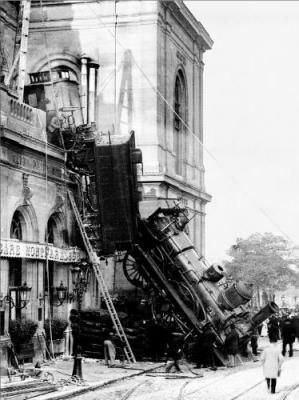Time 4:00 pm Trains 1 Date 22 October 1895 Passenger count 131 | Country France Passengers 131 Total number of deaths 1 (woman on the street) Injuries 6 | |
 | ||
Similar Gare de Lyon rail accident, Versailles rail accident, Great Train Wreck of 1918, Paris Métro train fire, Lagny‑Pomponne rail accident | ||
Montparnasse derailment news
The Montparnasse derailment occurred at 4:00 pm on October 22, 1895 when the Granville–Paris Express overran the buffer stop at its Gare Montparnasse terminus. With the train several minutes late and the driver trying to make up for lost time, it entered the station too fast and the train air brake failed. After running through the buffer stop, the train crossed the station concourse and crashed through the station wall; the locomotive fell onto the Place de Rennes below, where it stood on its nose. A woman in the street below was killed by falling masonry. The engineer was fined 50 francs and one of the guards 25 francs.
Contents
Derailment
On October 22, 1895 the Granville to Paris Montparnasse express, operated by Chemins de fer de l'Ouest, was composed of steam locomotive No. 721 (a type 2-4-0, French notation 120) was made up with 10 vehicles hauling three luggage vans, a post van, and six passenger coaches. The train had left Granville on time at 8:45 am, but was several minutes late as it approached its Paris Montparnasse terminus with 131 passengers on board. In an effort to make up lost time the train entered the station too fast, at a speed of 40-60km/h, and the Westinghouse air brake failed to stop it. Without sufficient braking, the momentum of the train carried it slowly into the buffers, and the locomotive crossed the almost 30m wide station concourse, crashing through a 60cm thick wall, before falling onto the Place de Rennes 10m below, where it stood on its nose. A woman in the street below was killed by falling masonry; and two passengers, the fireman, two guards and a passerby in the street sustained injuries.
The woman, Marie-Augustine Aguilard, had been standing in for her husband, a newspaper vendor, while he went to collect the evening newspapers.
Aftermath
The locomotive driver was fined 50 francs for approaching the station too fast. One of the guards was fined 25 francs as he had been preoccupied with paperwork and failed to apply the handbrake.
The passenger carriages were undamaged and were easily removed. It took forty-eight hours before the legal process and investigation allowed the railway to start removing the locomotive and tender. An attempt was made to move the locomotive with fourteen horses, but this failed. A 250 tonne winch with ten men first lowered the locomotive to the ground and then lifted the tender back into the station. When the locomotive reached the railway workshops it was found to have suffered little damage.
Legacy
The wreckage remained outside the station for several days and a number of photographs were taken, such as those attributed to Studio Lévy and Sons, L. Mercier, and Henri Roger-Viollet.
The Lévy and Sons photograph (at the top of the article) has become one of the most famous in transportation history. The photograph, which is out of copyright, is used as the cover page in the book An Introduction to Error Analysis by John Taylor. The picture is also featured on the front cover of American hard rock band Mr. Big's 1991 album, Lean into It.
Pictures of this accident have been associated with the "fail" meme.
A near-identical train crash in the same location appears as a dream in the novel The Invention of Hugo Cabret and its film adaptation, Hugo, and is depicted in the comic book The Extraordinary Adventures of Adèle Blanc-Sec. Gordon's crash at Kirk Ronan in the Thomas & Friends episode "A Better View for Gordon" was inspired by the Montparnasse derailment.
An imitation of the Montparnasse derailment has been built outside the Mundo a Vapor ("Steam World") museum theme park in Canela, Brazil.
